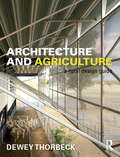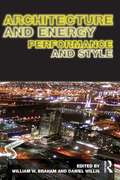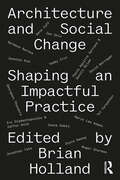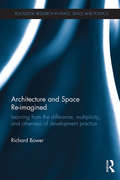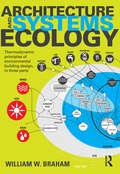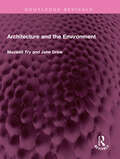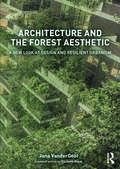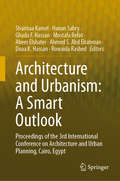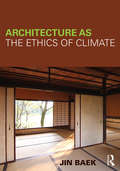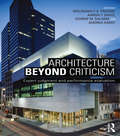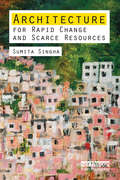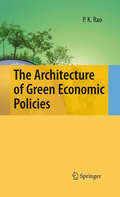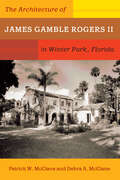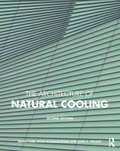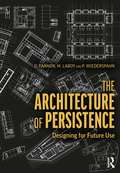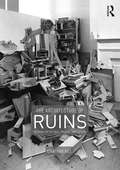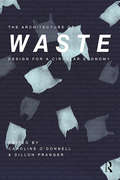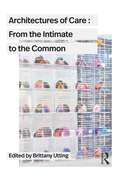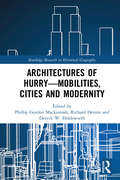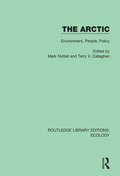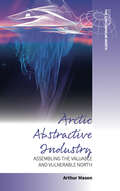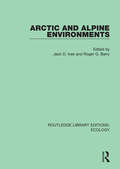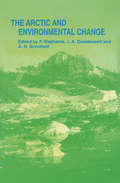- Table View
- List View
Architecture and Agriculture: A Rural Design Guide
by Dewey ThorbeckArchitecture and Agriculture: A Rural Design Guide presents architectural guidelines for buildings designed and constructed in rural landscapes by emphasizing their connections with function, culture, climate, and place. Following on from the author’s first book Rural Design, the book discusses in detail the buildings that humans construct in support of agriculture. By examining case studies from around the world including Australia, China, Japan, Norway, Poland, Japan, Portugal, North America, Africa and the Southeast Asia it informs readers about the potentials, opportunities, and values of rural architecture, and how they have been developed to create sustainable landscapes and sustainable buildings for rapidly changing rural futures.
Architecture and Energy: Performance and Style
by William W. Braham Daniel WillisDoes energy consumption influence architectural style? Should more energy-efficient buildings look different? Can that "look" be used to explain or enhance their performance? Architecture and Energy provides architects and architectural theorists with more durable arguments for environmental design decisions, arguments addressing three different scales or aspects of contemporary construction. By drawing together essays from the leading experts in the field, this book engages with crucial issues in sustainable design, such as: The larger role of energy in forming the cultural and economic systems in which architecture is conceived, constructed, and evaluated The different measures and meanings of energy "performance" and how those measures are realized in buildings The specific ways in which energy use translates into the visible aspects of architectural style. Drawing on research from the UK, US, Europe, and Asia the book outlines the problems surrounding energy and architecture and provides the reader with a considered overview of this important topic.
Architecture and Social Change: Shaping an Impactful Practice
by Brian HollandArchitecture and Social Change is a timely, and urgently needed, survey of social and environmental justice advocacy in architecture. Spotlighting contemporary design and research practitioners who are creatively leveraging their expertise for social change, this book features interviews with fifteen influential design leaders who are at the forefront of their profession’s efforts to confront pressing challenges like housing insecurity, racial and economic inequality, environmental degradation, and architectural waste. Among the interviewees are Dana Cuff, who, as director of cityLAB, is helping to reshape housing policy in California; Joana Dabaj, cofounder of the design charity CatalyticAction, which empowers refugee children from the Syrian civil war to act as “co-designers” of playgrounds and public spaces in Lebanon; and Ivi Diamantopoulou and Jaffer Kolb of New York City–based New Affiliates, who repurpose, through lively recontextualization, the architectural byproducts of their city’s museum exhibitions and building-performance mockups. These insightful student-led interviews compellingly capture the current moment of soul-searching in both the profession and the academy.An indispensable guide for design students and professionals alike, Architecture and Social Change gathers inspirational stories alongside practical advice for how to navigate a career in architecture while seeking to make a positive impact.
Architecture and Space Re-imagined: Learning from the difference, multiplicity, and otherness of development practice (Routledge Research in Place, Space and Politics)
by Richard BowerAs with so many facets of contemporary western life, architecture and space are often experienced and understood as a commodity or product. The premise of this book is to offer alternatives to the practices and values of such westernised space and Architecture (with a capital A), by exploring the participatory and grass-roots practices used in alternative development models in the Global South. This process re-contextualises the spaces, values, and relationships produced by such alternative methods of development and social agency. It asks whether such spatial practices provide concrete realisations of some key concepts of Western spatial theory, questioning whether we might challenge the space and architectures of capitalist development by learning from the places and practices of others. Exploring these themes offers a critical examination of alternative development practices methods in the Global South, re-contextualising them as architectural engagements with socio-political space. The comparison of such interdisciplinary contexts and discourses reveals the political, social, and economic resonances inherent between these previously unconnected spatial protagonists. The interdependence of spatial issues of choice, value, and identity are revealed through a comparative study of the discourses of Henri Lefebvre, John Turner, Doreen Massey, and Nabeel Hamdi. These key protagonists offer a critical framework of discourses from which further connections to socio-spatial discourses and concepts are made, including post-marxist theory, orientalism, post-structural pluralism, development anthropology, post-colonial theory, hybridity, difference and subalterneity. By looking to the spaces and practices of alternative development in the Global South this book offers a critical reflection upon the working practices of Westernised architecture and other spatial and political practices. In exploring the methodologies, implications and values of such participatory development practices this book ultimately seeks to articulate the positive potential and political of learning from the difference, multiplicity, and otherness of development practice in order to re-imagine architecture and space. .
Architecture and Systems Ecology: Thermodynamic Principles of Environmental Building Design, in three parts
by William W. BrahamModern buildings are both wasteful machines that can be made more efficient and instruments of the massive, metropolitan system engendered by the power of high-quality fuels. A comprehensive method of environmental design must reconcile the techniques of efficient building design with the radical urban and economic reorganization that we face. Over the coming century, we will be challenged to return to the renewable resource base of the eighteenth-century city with the knowledge, technologies, and expectations of the twenty-first-century metropolis. This book explores the architectural implications of systems ecology, which extends the principles of thermodynamics from the nineteenth-century focus on more efficient machinery to the contemporary concern with the resilient self-organization of ecosystems. Written with enough technical material to explain the methods, it does not include in-text equations or calculations, relying instead on the energy system diagrams to convey the argument. Architecture and Systems Ecology has minimal technical jargon and an emphasis on intelligible design conclusions, making it suitable for architecture students and professionals who are engaged with the fundamental issues faced by sustainable design. The energy systems language provides a holistic context for the many kinds of performance already evaluated in architecture—from energy use to material selection and even the choice of building style. It establishes the foundation for environmental principles of design that embrace the full complexity of our current situation. Architecture succeeds best when it helps shape, accommodate, and represent new ways of living together.
Architecture and the Environment (Routledge Revivals)
by Maxwell Fry Jane DrewFirst published in 1976 Architecture and the Environment is based on the authors very successful Architecture of Children. The original book has been completely revised and new illustrations have been specially drawn. This book gives a comprehensive account of the role of architecture in the environment of a constantly developing world. It traces the history of building from its most primitive origins to the complex architecture of the current times. The book takes as a starting- point ideas that will be familiar to all its readers, then leads them on to an examination of the attitudes and approaches of architects and planners, so that they can follow the creative process step by step. The style of the book is direct and very readable, with a minimum of technological language and will be useful for general readers interested in architecture.
Architecture and the Forest Aesthetic: A New Look at Design and Resilient Urbanism
by Jana VanderGootDespite population trends toward urbanization, the forest continues to have a strong appeal to the human imagination, and the human preference for forest over many other types of terrain is well documented. This book re-imagines architecture and urbanism by allowing the forest to be a prominent consideration in the language of design, thus recognizing the forest as essential rather than just incidental to human well-being. In Architecture and the Forest Aesthetic, forest is a large-scale urban construct that is far more extensive and nuanced than trees and shrubbery. The forest aesthetic opens designers to the forest as a model for an urban architecture of permeable floors, protective canopies, connected food chains, beneficial decomposition, and resilient ecologies. Much can be learned about these features of the forest from the natural sciences; however, when they are given due consideration technically and metaphorically in the design of urban habitat, the places in which humans live become living forests. What is present here in Architecture and the Forest Aesthetic is both a review of many ingenious ways in which the forest aesthetic has already been expressed in design and urbanism, and an encouragement to further use the forest aesthetic in design language and design outcomes. Case study projects featured include the Chilotan building craft of Southern Chile, the yaki sugi of Japan, the Biltmore Forest in the Southeastern United States, the Australian capital city Canberra, Bosco Verticale in Milan, Italy, the Beijing Olympic Forest Park in China, and more.
Architecture and Urbanism: Proceedings of the 3rd International Conference on Architecture and Urban Planning, Cairo, Egypt
by Shaimaa Kamel Hanan Sabry Ghada F. Hassan Mostafa Refat Abeer Elshater Ahmed S. Abd Elrahman Doaa K. Hassan Rowaida RashedThis proceedings addresses the challenges of urbanization that gravely affect the world’s ecosystems. To become efficiently sustainable and regenerative, buildings and cities need to adopt smart solutions. This book discusses innovations of the built environment while depicting how such practices can transform future buildings and urban areas into places of higher value and quality. The book aims to examine the interrelationship between people, nature and technology, which is essential in pursuing smart environments that optimize human wellbeing, motivation and vitality, as well as promoting cohesive and inclusive societies: Urban Sociology - Community Involvement - Place-making and Cultural Continuity – Environmental Psychology - Smart living - Just City. The book presents exemplary practical experiences that reflect smart strategies, technologies and innovations, by established and emerging professionals, provides a forum of real-life discourse. The primary audience for the work will be from the fields of architecture, urban planning and built-environment systems, including multi-disciplinary academics as well as professionals.
Architecture as the Ethics of Climate
by Jin BaekAt a time when climate and ethics have become so important to architectural debate, this book proposes an entirely new way for architects to engage with these core issues. Drawing on Tetsuro Watsuji‘s (1889-1960) philosophy, the book illuminates climate not as a collection of objective natural phenomena, but as a concrete form of bond in which "who we are"—the subjective human experience—is indivisibly intertwined with the natural phenomena. The book further elucidates the inter-personal nature of climatic experiences, criticizing a view that sees atmospheric effects of climate under the guise of personal experientialism and reinforcing the linkage between climate and ethos as the appropriateness of a setting for human affairs. This ethical premise of climate stretches the horizon of sustainability as pertaining not only to man’s solitary relationship with natural phenomena—a predominant trend in contemporary discourse of sustainability—but also to man’s relationship with man. Overcoming climatic determinism—regional determinism, too—and expanding the ethics of the inter-personal to the level where the whole and particulars are joined through the dialectics of the mutually-negating opposites, Jin Baek develops a new thesis engaging with the very urgent issues inherent in sustainable architecture. Crucially, the book explores examples that join climate and the dynamics of the inter-personal, including: Japanese vernacular residential architecture the white residential architecture of Richard Neutra contemporary architectural works and urban artifacts by Tadao Ando and Aldo Rossi Beautifully illustrated, this book is an important contribution to the discourse which surrounds architecture, climate and ethics and encourages the reader to think more broadly about how to respond to the current challenges facing the profession.
Architecture Beyond Criticism: Expert Judgment and Performance Evaluation
by Wolfgang F. Preiser Aaron T. Davis Ashraf M. Salama Andrea HardyFor the first time, this book demonstrates that the two paradigms of architectural criticism and performance evaluation can not only co-exist but complement each other in the assessment of built works. As architecture takes more principled stances worldwide, from environmental sustainability to social, cultural, and economic activism, this book examines the roles of perceived and measured quality in architecture. By exploring in tandem both subjective traditional architectural criticism and environmental design and performance evaluation and its objective evaluation criteria, the book argues that both methodologies and outcomes can achieve a comprehensive assessment of quality in architecture. Curated by a global editorial team, the book includes: Contributions from international architects and critics based in the UK, USA, Brazil, France, Qatar, Egypt, New Zealand, China, Japan and Germany Global case studies which illustrate both perspectives addressed by the book and comparative analyses of the findings A six part organization which includes introductions and conclusions from the editors, to help guide the reader and further illuminate the contributions. By presenting a systematic approach to assessing building performance, design professionals will learn how to improve building design and performance with major stakeholders in mind, especially end users/occupants.
Architecture Competition: Project Design and the Building Process (Design and the Built Environment)
by Ignaz Strebel Jan SilberbergerMuch valued by design professionals, controversially discussed in the media, regularly misunderstood by the public and systematically regulated by public procurement; in recent years, architecture competitions have become projection screens for various and often incommensurable desires and hopes. Almost all texts on architectural competition engage it for particular reasons, whether these be for celebration of the procedure, or dismissal. Moving on from such polarised views, Architecture Competition is a revelatory study on what really happens when competitions take place. But the story is not just about architecture and design; it is about the whole construction process, from the definition of the spatial programme, to judgement and selection of projects and the realization of the building. This book explores the competition in the building process as it takes place, but also before and after its execution. It demonstrates that competitions are not just one step of many to be taken, but that competitive design procedures shape the entire process. Along the way the book exposes, among others, one of the key evolutions of design competitions – that competition procedures need to be regulated in order to respond to public awarding rules and need to integrate an increasing amount of given standards regarding, for example, efficiency, fire safety and thermal comfort. These notions force competing architects to respond to inflexible and overloaded competition programmes instead of focusing on genuinely crafting an architectural project. If the architecture competition wants to be more highly valued as a design tool, it should pay attention to the iterative nature of design and to the fact that perspectives on the problem often change in process.
Architecture for Rapid Change and Scarce Resources
by Sumita SinhaArchitects, development practitioners and designers are working in a global environment and issues such as environmental and cultural sustainability matter more than ever. Past interactions and interventions between developed and developing countries have often been unequal and inappropriate. We now need to embrace fresh design practices based on respect for diversity and equality, participation and empowerment. This book explores what it means for development activists to practise architecture on a global scale, and provides a blueprint for developing architectural practices based on reciprocal working methods. The content is based on real situations - through extended field research and contacts with architecture schools and architects, as well as participating NGOs. It demonstrates that the ability to produce appropriate and sustainable design is increasingly relevant, whether in the field of disaster relief, longer-term development or wider urban contexts, both in rich countries and poor countries.
The Architecture of Green Economic Policies
by P. K. RaoThe role of environmental analysis in economic policy making has remained largely limited despite vast literature on environmental economics and governance. An effective integration of economic and environmental sciences with pragmatic design of institutions and policies is still urgently needed for practical use. This book offers a policy framework for economic policies that meaningfully integrate environmental and ecological resource factors. Based on analyses and new insights on sustainable development, this book provides pragmatic approaches for economic policy formulation and implementation, as well as for institutional reform. Thematic aspects include trade and environment, poverty and environment, recognition and accounting of factor limitations beyond traditional economic analyses, and an efficient choice of market and regulatory regimes for effective economic, environmental and social governance.
The Architecture of James Gamble Rogers II in Winter Park, Florida
by Patrick W. McClane Debra A. McClaneExploring the life and career of one of Florida's premier architectsThis well-illustrated book illuminates the life and career of one of Florida's premier architects, whose elegant homes and design aesthetic shaped the architectural character of Winter Park and influenced urban development throughout central Florida.James Gamble Rogers II (1901-1990) created homes known for their human scale and proportion and for their suitability to the environment. This work highlights twelve of these residences designed for Winter Park, the beautiful small city adjacent to Orlando and the headquarters of the Rogers family architecture firm, Rogers, Lovelock, and Fritz, which exists today under the leadership of Rogers' son. Ingeniously meeting the special needs of Florida's climate—heat, humidity, termite control, and air circulation--the residences incorporate details from a variety of historical styles, including eccletic and authentic features that emulate vernacular Spanish farmhouses and villas.The book includes critiques of each design and its evolution, particulars about the site, and stories about the lives and tastes of the clients—men and women of wealth and status who influenced the heady era of the Florida land boom in the 1920s and 1930s. Numerous floor plans, modern and historical photographs, and Rogers' own drawings augment the discussion.The book also presents an entertaining biography of Rogers, with information on his schooling, a history of the firm he founded, and his familial connections with the architectural profession (his uncle and namesake designed more than 20 buildings for Yale University). It describes his success in the areas of governmental, military, and university architecture, including his designs for buildings at Rollins College in Winter Park, and evaluates his impact on 20th-century architecture in Florida and throughout the nation.Coauthors Patrick and Debra McClane have studied Rogers' original drawings, toured his homes, and interviewed clients and family members; Patrick McClane worked at the Rogers firm during the architect's last years there and brings a personal connection to this work. Their book documents an exceptional contribution to Florida's architectural heritage, the life and work of a man who created stylish and desirable homes and distinctive public buildings.With a detailed appendix that lists dates and addresses for nearly 275 houses, most of them still extant, the work will serve as the definitive guide to Rogers' work in Winter Park.
The Architecture of Natural Cooling
by Brian Ford Rosa Schiano-Phan Juan A. VallejoOverheating in buildings is commonplace. This book describes how we can keep cool without conventional air-conditioning: improving comfort and productivity while reducing energy costs and carbon emissions. It provides architects, engineers and policy makers with a ‘how-to’ guide to the application of natural cooling in new and existing buildings. It demonstrates, through reference to numerous examples, that natural cooling is viable in most climates around the world. This completely revised and expanded second edition includes: An overview of natural cooling past and present. Guidance on the principles and strategies that can be adopted. A review of the applicability of different strategies. Explanation of simplified tools for performance assessment. A review of components and controls. A detailed evaluation of case studies from the USA, Europe, India and China. This book is not just for the technical specialist, as it also provides a general grounding in how to avoid or minimise air-conditioning. Importantly, it demonstrates that understanding our environment, rather than fighting it, will help us to live sustainably in our rapidly warming world.
The Architecture of Persistence: Designing for Future Use
by David Fannon Michelle Laboy Peter WiederspahnThe Architecture of Persistence argues that continued human use is the ultimate measure of sustainability in architecture, and that expanding the discourse about adaptability to include continuity as well as change offers the architectural manifestation of resilience. Why do some buildings last for generations as beloved and useful places, while others do not? How can designers today create buildings that remain useful into the future? While architects and theorists have offered a wide range of ideas about building for change, this book focuses on persistent architecture: the material, spatial, and cultural processes that give rise to long-lived buildings. Organized in three parts, this book examines material longevity in the face of constant physical and cultural change, connects the dimensions of human use and contemporary program, and discusses how time informs the design process. Featuring dozens of interviews with people who design and use buildings, and a close analysis of over a hundred historic and contemporary projects, the principles of persistent architecture introduced here address urgent challenges for contemporary practice while pointing towards a more sustainable built environment in the future. The Architecture of Persistence: Designing for Future Use offers practitioners, students, and scholars a set of principles and illustrative precedents exploring architecture’s unique ability to connect an instructive past, a useful present, and an unknown future.
The Architecture of Ruins: Designs on the Past, Present and Future
by Jonathan HillThe Architecture of Ruins: Designs on the Past, Present and Future identifies an alternative and significant history of architecture from the sixteenth century to the twenty-first century, in which a building is designed, occupied and imagined as a ruin. This design practice conceives a monument and a ruin as creative, interdependent and simultaneous themes within a single building dialectic, addressing temporal and environmental questions in poetic, psychological and practical terms, and stimulating questions of personal and national identity, nature and culture, weather and climate, permanence and impermanence and life and death. Conceiving a building as a dialogue between a monument and a ruin intensifies the already blurred relations between the unfinished and the ruined and envisages the past, the present and the future in a single architecture. Structured around a collection of biographies, this book conceives a monument and a ruin as metaphors for a life and means to negotiate between a self and a society. Emphasising the interconnections between designers and the particular ways in which later architects learned from earlier ones, the chapters investigate an evolving, interdisciplinary design practice to show the relevance of historical understanding to design. Like a history, a design is a reinterpretation of the past that is meaningful to the present. Equally, a design is equivalent to a fiction, convincing users to suspend disbelief. We expect a history or a novel to be written in words, but they can also be delineated in drawing, cast in concrete or seeded in soil. The architect is a ‘physical novelist’ as well as a ‘physical historian’. Like building sites, ruins are full of potential. In revealing not only what is lost, but also what is incomplete, a ruin suggests the future as well as the past. As a stimulus to the imagination, a ruin’s incomplete and broken forms expand architecture’s allegorical and metaphorical capacity, indicating that a building can remain unfinished, literally and in the imagination, focusing attention on the creativity of users as well as architects. Emphasising the symbiotic relations between nature and culture, a building designed, occupied and imagined as a ruin acknowledges the coproduction of multiple authors, whether human, non-human or atmospheric, and is an appropriate model for architecture in an era of increasing climate change.
The Architecture of Waste: Design for a Circular Economy
by Caroline O’DonnellGlobal material crises are imminent. In the very near future, recycling will no longer be a choice made by those concerned about the environment, but a necessity for all. This means a paradigm shift in domestic behavior, manufacturing, construction, and design is inevitable. The Architecture of Waste provides a hopeful outlook through examining current recycling practices, rethinking initial manufacturing techniques, and proposing design solutions for second lives of material-objects. The book touches on a variety of inescapable issues beyond our global waste crisis including cultural psyches, politics, economics, manufacturing, marketing, and material science. A series of crucial perspectives from experts cover these topics and frames the research by providing a past, present, and future look at how we got here and where we go next: the historical, the material, and the design. Twelve design proposals look beyond the simple application of recycled and waste materials in architecture—an admirable endeavor but one that does not engage the urgent reality of a circular economy—by aiming to transform familiar, yet flawed, material-objects into closed-loop resources. Complete with over 150 color images and written for both professionals and students, The Architecture of Waste is a necessary reference for rethinking the traditional role of the architect and challenging the discipline to address urgent material issues within the larger design process.
Architectures of Care: From the Intimate to the Common
by Brittany UttingDrawing from a diverse range of interdisciplinary voices, this book explores how spaces of care shape our affective, material, and social forms, from the most intimate scale of the body to our planetary commons.Typical definitions of care center around the maintenance of a livable life, encompassing everything from shelter and welfare to health and safety. Architecture plays a fundamental role in these definitions, inscribed in institutional archetypes such as the home, the hospital, the school, and the nursery. However, these spaces often structure modes of care that prescribe gender roles, bodily norms, and labor practices. How can architecture instead engage with an expanded definition of care that questions such roles and norms, producing more hybrid entanglements between our bodies, our collective lives, and our environments? Chapters in this book explore issues ranging from disabled domesticities and nursing, unbuilding whiteness in the built environment, practices and pedagogies of environmental care, and the solidarity networks within ‘The Cloud’. Case studies include Floating University Berlin, commoning initiatives by the Black Panther party, and hospitals for the United Mine Workers of America, among many other sites and scales of care.Exploring architecture through the lenses of gender studies, labor theory, environmental justice, and the medical humanities, this book will engage students and academics from a wide range of disciplines.
Architectures of Hurry—Mobilities, Cities and Modernity (Routledge Research in Historical Geography)
by Phillip Gordon Mackintosh Richard Dennis Deryck W. Holdsworth‘Hurry’ is an intrinsic component of modernity. It exists not only in tandem with modern constructions of mobility, speed, rhythm, and time–space compression, but also with infrastructures, technologies, practices, and emotions associated with the experience of the ‘mobilizing modern’. ‘Hurry’ is not simply speed. It may result in congestion, slowing-down, or inaction in the face of over-stimulus. Speeding-up is often competitive: faster traffic on better roads made it harder for pedestrians to cross, or for horse-drawn vehicles and cyclists to share the carriageway with motorized vehicles. Focusing on the cultural and material manifestations of ‘hurry’, the book’s contributors analyse the complexities, tensions, and contradictions inherent in the impulse to higher rates of circulation in modernizing cities. The collection includes, but also goes beyond, accounts of new forms of mobility (bicycles, buses, underground trains) and infrastructure (street layouts and surfaces, business exchanges, and hotels) to show how modernity’s ‘architectures of hurry’ have been experienced, represented, and practised since the mid nineteenth century. Ten case studies explore different expressions of ‘hurry’ across cities and urban regions in Asia, Europe, and North and South America, and substantial introductory and concluding chapters situate ‘hurry’ in the wider context of modernity and mobility studies and reflect on the future of ‘hurry’ in an ever-accelerating world. This diverse collection will be relevant to researchers, scholars, and practitioners in the fields of planning, cultural and historical geography, urban history, and urban sociology.
The Arctic: Environment, People, Policy (Routledge Library Editions: Ecology #10)
by Mark Nuttall Terry V. CallaghanOriginally published in 2000, The Arctic provides a comprehensive overview of the region's rapidly changing physical and human dimensions, and demonstrates the importance of communication between natural scientists, social scientists, and local stakeholders in response to the tremendous challenges and opportunities facing the Arctic. It is an essential resource for all Arctic researchers, particularly those developing multidisciplinary projects. It provides an overview of key areas of Arctic research by renowned specialists in the field, and each chapter forms a detailed, varied and accessible account of current knowledge. Each author introduces the subject to a specialist readership, while retaining intellectual integrity and relevance for specialists. Overall, the richness of the material presented in this volume reflects the ecological and cultural diversity of this vast and environmentally critical part of the globe.
Arctic Abstractive Industry: Assembling the Valuable and Vulnerable North (Studies in the Circumpolar North #5)
by Arthur MasonThrough diverse engagements with natural resource extraction and ecological vulnerability in the contemporary Arctic, contributors to this volume apprehend Arctic resource regimes through the concept of abstraction. Abstraction refers to the creation of new material substances and cultural values by detaching parts from existing substances and values. The abstractive process differs from the activity of extractive industries by its focus on the conceptual resources that conceal processes of exploitation associated with extraction. The study of abstraction can thus help us attune to the formal operations that make appropriations of value possible while disclosing the politics of extraction and of its representation.
Arctic Abstractive Industry: Assembling the Valuable and Vulnerable North (Studies in the Circumpolar North #5)
by Arthur MasonThrough diverse engagements with natural resource extraction and ecological vulnerability in the contemporary Arctic, contributors to this volume apprehend Arctic resource regimes through the concept of abstraction. Abstraction refers to the creation of new material substances and cultural values by detaching parts from existing substances and values. The abstractive process differs from the activity of extractive industries by its focus on the conceptual resources that conceal processes of exploitation associated with extraction. The study of abstraction can thus help us attune to the formal operations that make appropriations of value possible while disclosing the politics of extraction and of its representation.
Arctic and Alpine Environments (Routledge Library Editions: Ecology #6)
by Jack D. Ives; Roger G. BarryOriginally published in 1974, Arctic and Alpine Environments examines, the relatively simple ecosystems of arctic and alpine lands that still occupy extensive areas little disturbed by modern technology. The book argues that there is a necessity for carefully controlled development of the resources of these regions and suggests that there is a risk of irreversible disturbance without full understanding of these regions. This book provides a detailed documentation of cold-stressed arctic and alpine terrestrial environments and systematically deals with the present and past physical environment – climate, hydrology and glaciology; biota – treeline, vegetation, vertebrate zoology, and historical biogeography; abiotic processes – geomorphological and pedological and the role of man – bioclimatology, archaeology and technological impact, including radioecology. The book will appeal to academics and students of environmental and biological science, as well as providing a significant source for conservationists’, government agencies and industrial organizations.
Arctic and Environmental Change
by J. A. DowdeswellThis timely book presents a wide-ranging review of Arctic environmental change in response to global warming, and gives a broad insight into the transformation of the Arctic which we can expect during the next century. It is in high northern latitudes that we can expect to observe global warming at its most powerful, making it a natural laboratory where climate changes and their impacts can be monitored and studied more readily than elsewhere in the world. Fourteen authoritative reviews cover the predictions of warming rates by General Circulation Models; variabilities in atmospheric circulation and moisture flux; the dynamics of the polar vortex in the Arctic and its role in ozone loss; the countervailing influence of air pollution in reducing solar irradiance; and the impact of climatic change on Arctic terrestrial and marine ecosystems. Also detailed are the thermohaline circulation of the ocean, the extent and thickness of sea ice, the sizes of glaciers and ice sheets, and the extent of permafrost. Moving to past changes, the records from Greenland ice cores and deep ocean drilling are reviewed for what they tell us about past climates and glaciation in the Arctic., The book paints a vivid and disturbing picture of the enhanced warming that can be expected in the Arctic relative to lower latitudes, and of the major impacts that this will have on the northern cryosphere. It will be an invaluable reference for anyone seeking a greater understanding of the factors and processes affecting the arctic environment, which may ultimately have a major impact on global climatic change.
